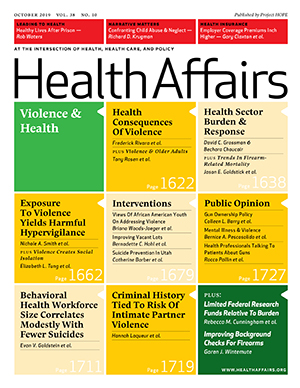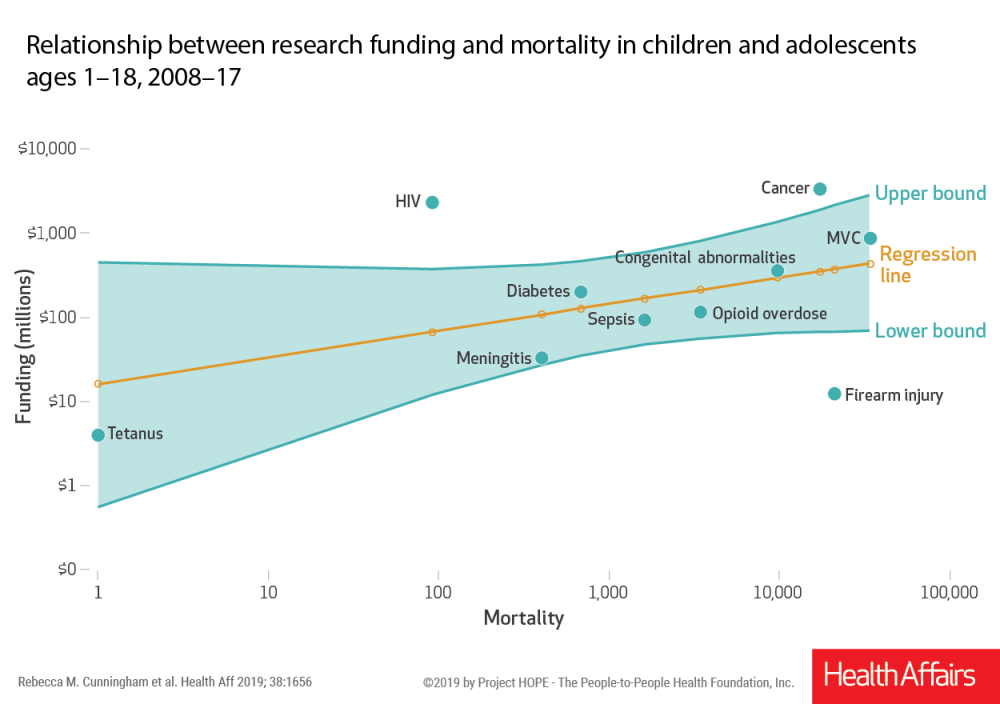|
Health Affairs Event
Los Angeles Briefing: Violence & Health
CONTACT
Debbie Boylan
Phone: 301-347-3910
Email: dboylan@projecthope.org
Join us in Los Angeles for a forum on Violence & Health - subject matter covered in the October Health Affairs issue. View Table of Contents
The forum will feature authors from a select group of studies contained in the issue, as well as community leaders, policy makers and residents who are developing and deploying strategies for combating violence in their daily lives:
- Raymond Baxter, President and CEO, Blue Shield of California Foundation
- Judy Belk, President and CEO, California Wellness Foundation
- Genevieve Flores-Haro, Associate Director, Mixteco/Indigena Community Organizing Project
- Sandra Henriquez, CEO, CalCASA (California Coalition Against Sexual Assault)
- Hannah Laqueur, Assistant Professor, Emergency Medicine, University of California, Davis, on "Alcohol-Related Crimes And Risk Of Arrest For Intimate Partner Violence Among California Handgun Purchasers"
- Robert Riewerts, Chair, Care Delivery Workgroup, Kaiser Permanente Task Force on Firearm Injury Prevention
- Anne Tremblay, Director, Gang Reduction & Youth Development (GRYD), Office of Mayor Eric Garcetti, City of Los Angeles
- Elizabeth Tung, Instructor of Medicine, University of Chicago School of Medicine, on "Social Isolation, Loneliness, And Violence Exposure In Urban Adults" and "Keeping Your Guard Up: Hypervigilance Among Urban Residents Affected By Community And Police Violence"
- Briana Woods-Jaeger, Assistant Professor, Behavioral Sciences and Health Education, Emory University, on "Mitigating Negative Consequences Of Community Violence Exposure: Perspectives From African American Youth"
*Additional speakers to be announced.
Get event-specific emails delivered directly to your inbox.
IN THE JOURNAL
NEW ISSUE: VIOLENCE & HEALTH
|
|
The October issue of Health Affairs examines the consequences of violence for victims, perpetrators, and communities. Although much attention is focused on mass violence incidents, the daily burden of violence often takes a greater toll.
The October issue was supported by The California Wellness Foundation, Blue Shield of California Foundation, the Joyce Foundation, and the Annie E. Casey Foundation.
Read the October 2019 table of contents.
Listen to a two-minute introduction of the issue from Editor-in-Chief Alan Weil.
Read "From the Editor in Chief." |

|
|
The Effects Of Violence On Health
By Frederick Rivara, Avanti Adhia, Vivian Lyons, Anne Massey, Brianna Mills, Erin Morgan, Maayan Simckes, and Ali Rowhani-Rahbar
Frederick Rivara and coauthors present an overview of the myriad ways in which violence affects health. After chronicling different forms of violence, ranging from child physical and sexual abuse to adult assaults to elder abuse, they point out our growing scientific understanding of the physical and psychological consequences of violence. Read More >>
Violence And The US Health Care Sector: Burden And Response
By David C. Grossman and Bechara Choucair
David Grossman and Bechara Choucair document how violence affects the health care sector. There were 2.3 million violence-related emergency department visits in 2017, 5 percent of which were due to firearms. They also point out that health care is the sector with the highest rate of workplace violence. Read More >>
Federal Funding For Research On The Leading Causes Of Death Among Children And Adolescents
By Rebecca M. Cunningham, Megan L. Ranney, Jason E. Goldstick, Sonia V. Kamat, Jessica S. Roche, and Patrick M. Carter
Rebecca Cunningham and coauthors examine federal research funding for the leading causes of child and adolescent death. Among the top three causes of death--motor vehicle crashes, firearm injury, and cancer--federal research funding for cancer is about $200,000 per death, for vehicle crashes is $26,000 per death, and for firearms is less than $600 per death. Read More >>

Background Checks For Firearm Purchases: Problem Areas And Recommendations To Improve Effectiveness
By Garen J. Wintemute
One strategy to reduce the incidence of violence is background checks prior to firearm purchase. This policy is broadly supported by the public. Garen Wintemute explores the shortcomings of existing policy in this area and recommends a broad set of changes designed to make background checks more effective. Read More >>
After Prison, Healthy Lives Built On Access To Care And Community
By Rob Waters
A North Carolina program helps recently released inmates connect to health care, social services, and support. Read More >>
This article appears in Health Affairs' series on Leading to Health.
|

THIS WEEK ON THE BLOG
FOLLOWING THE ACA
ACA Round-Up: HealthCare.gov Maintenance, MLR Data, And More
By Katie Keith (10/9/19)
On October 4, 2019, CMS released new medical loss ratio (MLR) data, announced its scheduled maintenance windows for HealthCare.gov for the 2020 open enrollment period, and provided a new resource for states interested in applying for a Section 1332 waiver. CMS also approved new entities to use the enhanced direct enrollment (EDE) pathway. Separately, the US Government Accountability Office released a report on the impact of the ACA on the Indian Health Service. Read More >>
Contraceptive Mandate Litigation: Latest Developments
By Katie Keith (10/7/19)
This post summarizes the status of cases stemming from litigation in California, Massachusetts, Pennsylvania, and Texas. Read More >>
VIOLENCE
When Prevention Isn't Enough: Managing School Mass Shootings Along The Risk Continuum
By Frank G. Straub, Christopher Nelson, Samantha Iovan, Joie D. Acosta, and Mahshid Abir (10/8/19)
For those shootings that are not prevented, communities need to take an evidence-based, multidisciplinary approach to detection/disruption, preparation, response, and recovery. Read More >>
Interrupting Violence In Durham, North Carolina
By Rob Waters (10/7/19)
Violence is a contagion that clusters and spreads geographically; cycles of violence can be interrupted and retaliation can be prevented through the work of trusted "violence interrupters"--like the staff of Bull City United. Read More >>
CULTURE OF HEALTH
Five Insights From The First Five Years Of Research On Building A Culture of Health
By Alonzo Plough and Lisa Simpson (10/11/19)
The Robert Wood Johnson Foundation and AcademyHealth, along with our numerous partners and stakeholders are continuing in our efforts to support research, policy, and practice toward building a Culture of Health. Read More >>
WORKFORCE IN THE COMMUNITY
Home-Based Primary Care: How The Modern Day "House Call" Improves Outcomes, Reduces Costs, And Provides Care Where It's Most Often Needed
By Thomas Cornwell (10/8/19)
When you look behind the numbers at the patient stories, home-based primary care goes from being a compelling concept to a "no brainer." Read More >>
MARKETS
Retroactive Enrollment: A Feasible Way To Bring Auto-Enrollment To The Individual Market
By Christen Linke Young (10/10/19)
While the backstop might introduce a form of public option, it would also bring a large pool of relatively healthy individuals into the risk pool and dramatically reduce health care providers' uncompensated care burdens, which could be an attractive trade-off for providers, insurers, and other stakeholders. Read More >>
CHILDREN'S HEALTH
The Surprising Roles That Landlords (And Philanthropy) Can Play In Promoting Children's Health
By Daniel Cohn and Cara Matteliano (10/9/19)
If health advocates want to make serious headway in protecting children from the lifelong effects of lead poisoning, they must get both public- and private-sector buy-in and develop solutions that work for all, including landlords. Leaders in Cleveland, Ohio, and Buffalo, New York, have built strong public-private partnerships to deploy new tools to help landlords make their properties safe. Various foundations--both place-based and national--are funding efforts to prevent lead poisoning. Read More >>
COSTS & SPENDING
Self-Insured Employers Are Using Price Transparency To Improve Contracting With Health Care Providers: The Indiana Experience
By Gloria Sachdev, Chapin White, and Ge Bai (10/7/19)
The Indiana experience suggests that self-insured employers, if equipped with useful price information, have the potential to become informed and effective shoppers and create value for themselves and their employees. Read More >>
ACCESS TO CARE
New Evidence Demonstrates That The Public Charge Rule Will Harm Immigrant Families and Others
By Leighton Ku (10/9/19)
On October 15, 2019, the Department of Homeland Security (DHS) plans to implement a "public charge" rule that would harm legal immigrants and their family members if they use Medicaid, the Supplemental Nutrition Assistance Program (SNAP), or public housing benefits or are predicted to use such benefits in the future. Read More >>
PATIENT CENTERED CARE
Dermatologists Collaborating Across Specialties For Better Patient Care
By George J. Hruza (10/9/19)
Health care is at a critical crossroads, and dermatology is adapting in response, alongside our peers in medicine. We are focused on the outcomes of millions of patients with skin diseases and associated comorbidities who rely on our expertise and training in the face of increasing challenges to accessing the health care they need. Read More >>

|